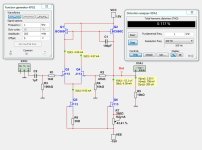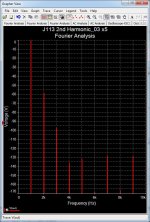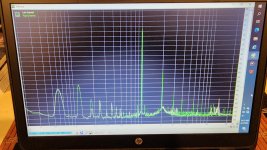Gain is like x5.
Distortion is not low: THD ~0.1%
This is the price you pay to get anything like tube sound.
Very low THD is not the way a sound of tube is like.
See the picture with Fourier Analysis. There is a lot of 2nd harmonic.
The rest of harmonics are very low.
The potentiometer is used to set the DC-offset.
Distortion is not low: THD ~0.1%
This is the price you pay to get anything like tube sound.
Very low THD is not the way a sound of tube is like.
See the picture with Fourier Analysis. There is a lot of 2nd harmonic.
The rest of harmonics are very low.
The potentiometer is used to set the DC-offset.
Attachments
Uneven harmonics are dominant.
Q1 and Q2 have no emitter resistors, makes this circuit temperature unstable.
Source impedance of Q3 and Q4 are different.
Gain is (47k + 10k) / 10k = 5.7x (15dB).
What does the Bode-plot look like?
Q1 and Q2 have no emitter resistors, makes this circuit temperature unstable.
Source impedance of Q3 and Q4 are different.
Gain is (47k + 10k) / 10k = 5.7x (15dB).
What does the Bode-plot look like?
Q1 and Q2 without resistors = mirror.
With resistors the 2nd harmonic will be lower.
The Q3 and Q4 are JFET. So the resistors need not be the same.
Gain is actually close to 5, not 5.7. Because of losses.
With resistors the 2nd harmonic will be lower.
The Q3 and Q4 are JFET. So the resistors need not be the same.
Gain is actually close to 5, not 5.7. Because of losses.
With resistors is also a mirror. I know that. Everybody knows that.
It's called emitter degeneration, decreases distortion.
In order to generate second harmonics, a 'logarithmic' bjt mirror is used with the abundant uneven harmonics as 'the price'.
Better do that with Jfets too, noise issues. It's not because of the high Z of the fets.
If this circuit has closed loop losses, then the open loop gain is to little and lots of distortion occur, as you noticed.
Can you post the open and closed loop Bode-plots better?
It's called emitter degeneration, decreases distortion.
In order to generate second harmonics, a 'logarithmic' bjt mirror is used with the abundant uneven harmonics as 'the price'.
Better do that with Jfets too, noise issues. It's not because of the high Z of the fets.
If this circuit has closed loop losses, then the open loop gain is to little and lots of distortion occur, as you noticed.
Can you post the open and closed loop Bode-plots better?
Not all tube preamps have high thd.
Schiit Freya has 0.004% as tube buffer and 0.01% as tube pre.
https://www.schiit.com/products/fre...5BgeJolY3QMd4w-rXL4oD2zZO_dKKLyAaAuvfEALw_wcB
Schiit Freya has 0.004% as tube buffer and 0.01% as tube pre.
https://www.schiit.com/products/fre...5BgeJolY3QMd4w-rXL4oD2zZO_dKKLyAaAuvfEALw_wcB
Made about five tube pre in the end, srpp circuit, the best sounding had ~0.02% thd.
https://www.diyaudio.com/community/threads/6n1-6n2-6n11-6dj8-in-pre.380485/
https://www.diyaudio.com/community/threads/6n1-6n2-6n11-6dj8-in-pre.380485/
Audio Research has been around for decades, making great tube stuff. Their pre has 10x lower thd than your simulated circuit.
https://www.stereophile.com/content/audio-research-reference-6se-line-preamplifier
https://www.stereophile.com/content/audio-research-reference-6se-line-preamplifier
With two emitter resistors to Q1 and Q2, size 22 Ohm, the THD is 0.013%.
With resistors 47 Ohm the THD is 0.006%.
Problem then is you can not hear the distortion ...
Nelson Pass has done several amplifiers with substancial high THD.
With resistors 47 Ohm the THD is 0.006%.
Problem then is you can not hear the distortion ...
Nelson Pass has done several amplifiers with substancial high THD.
Last edited:
Correct. I have quite a few of Mr. Nelson's designs, each has slightly different thd, and each has slightly different sound. Those amps with higher thd do not necessarily sound worse, on the contrary. Take VFET for example. Pretty high thd, yet pleasing sound with great soundstage. Opposite would be F5, very analytical, low thd.With two emitter resistors to Q1 and Q2, size 22 Ohm, the THD is 0.013%.
With resistors 47 Ohm the THD is 0.006%.
Problem then is you can not hear the distortion ...
Nelson Pass has done several amplifiers with substancial high THD.
I got F4, three versions of F5, two AlephJ, quite a few versions of F1J, few ACA, two F3 and most recently J2. Not to mention other amps, like JLH and chip amps.
There is no correlation between thd and sound. Things are way more complicated.
I do not care if amplifier has relatively high distortion, as long as it gives me listening pleasure.
Recently been building few versions of pre with just buffer and stepup transformer. Basically what is front in VFET or M2. Similar to ZM iron pre. Amazing sound. Yes, step up transformer is the key, because of its pleasing distortion.
But there is other factor. No feedback.
I have been accused many times by various members here of 'putting shades on mona lisa', whatever that means. Or creating 'effect' box. All these bimbos and pseudoengineers keep repeating their attacks, who cares. If nutube b1 pre sounds better to me than overengineered six zeros low thd pre, i can't help it.
Unless we figure out what exactly to measure, thd itself is not enough.
I have no mos-database, so you have to find a suitable part yourself.MOSFET I have is ZVP3310A.
But I think they have Vgs like 2 Volt.
What MOSFET do you suggest - which is possible to find a model for SPICE?
Here is one version with 10 Ohm emitter resistors:
THD drops from 0.117% to 0.028%
View attachment 1179796
A quick search: BSD223P (77K+ stock @ Farnll, $0.50) which is a dual Pch mos with a Vt < 0.9V.
https://www.omnicalculator.com/physics/mosfet-threshold-voltage
Q1 is running on ~5mA, so the re=5ohm; Q2 at 5.5mA, re=4.5ohm
Re's are 10ohm, so this increase of Re-total from 5 (exponential logarithmic) ohm to 15 (flattened exponential logarithmic) ohm ( 15/5=3x) decreases the distortion with (0.117/0.028=) 4.2x.
With 22 ohm (5.4) yields 9x less D, 47 ohm (10.4) is 19.5 less.
So, you're listening and liking a mix of jfet, bjt and lack of open loop gain ("Because of losses.") distortion.
I'm not sure if this kind of (simulated) 'tube-sound' is close to the real thing or vfets.
To get a clue of the open loop gain: can you (simulate) an AC signal measurement on the Q3drain - Q1basecollector - Q2base node?
Should be low, mV or uV.
Why the 198mVp input voltage?
....sounds better to me in my system than overengineered...... If nutube b1 pre sounds better to me than overengineered six zeros low thd pre, i can't help it.
...
would be better?
//
System is a chain of signal sources, pre and amplification, including eq and active crossovers, lastly speakers. So three main things. All are important, because its a chain.
All parts of the chain have to work in synergy.
Its quite possible that amplifier can sound good with certain speakers, but pretty bad with other. For numerous reasons, damping, wrong impedance, and so on. Sharp sounding amp with sharp sounding speakers is not going to work.
But than again, there is no correlation between simple thd number and sound.
Please do not correct my post.
All parts of the chain have to work in synergy.
Its quite possible that amplifier can sound good with certain speakers, but pretty bad with other. For numerous reasons, damping, wrong impedance, and so on. Sharp sounding amp with sharp sounding speakers is not going to work.
But than again, there is no correlation between simple thd number and sound.
Please do not correct my post.
Is there someone who have tested tube amplifier to see how the spectrum looks?
Display an image here.
The only thing I know is there is a major 2nd harmonic. This is the typically.
Also there are many different tube amplifiers. With or without feeedback.
Using inductor output or not.
Is there actually something like 'Tube Sound'?
Display an image here.
The only thing I know is there is a major 2nd harmonic. This is the typically.
Also there are many different tube amplifiers. With or without feeedback.
Using inductor output or not.
Is there actually something like 'Tube Sound'?
I used to have bottlehead pre, complete with ccs upgrades. I may try to find its harmonic profile. But i measured my srpp circuits, there is lots of data in my thread already.
- Home
- Source & Line
- Analog Line Level
- JFET Line Preamp. Gain 5 and Tube Sound.


